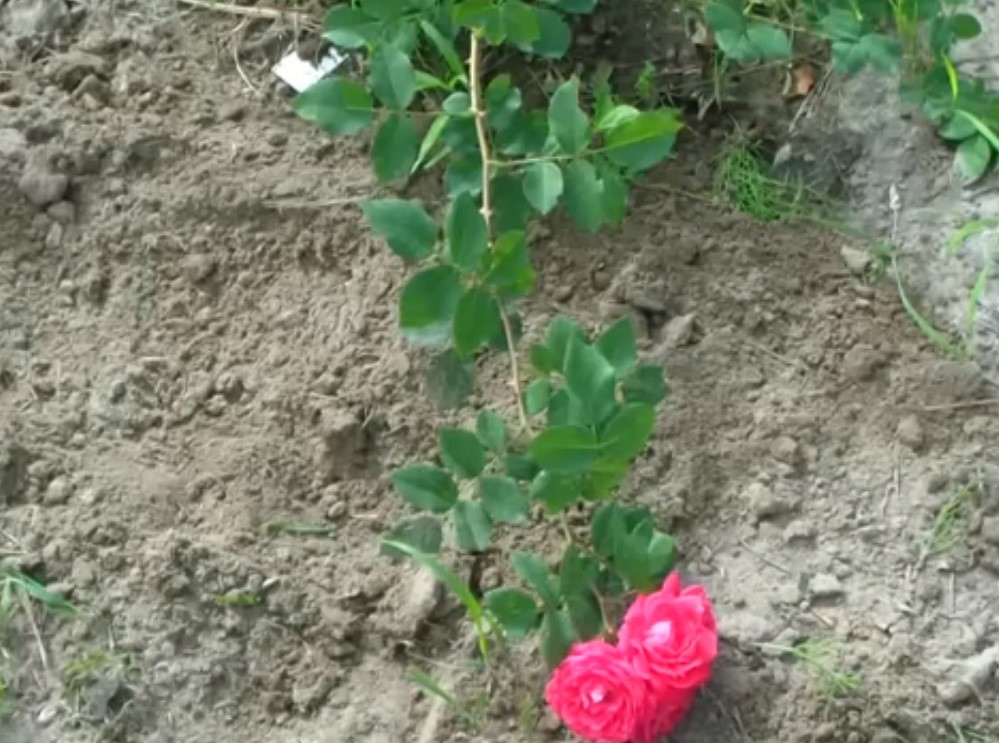Content
Many gardeners eventually think about propagating their favorite rose variety. However, there is an opinion that this is not so easy to do. But, according to experienced gardeners, propagating roses by layering is one of the easiest ways to get new seedlings. But it’s worth figuring out how to do it correctly. In addition, you need to know how to properly care for young seedlings in the future so that they can fully develop.

Reproduction by layering does not provide 100% survival rate
Is it possible to propagate a rose by layering?
Vegetative propagation for most types of roses is the only way to obtain bushes that retain all species properties. However, most often gardeners use cuttings for this. Although it is easy to grow seedlings from cuttings if this procedure is carried out correctly. Such shrubs are self-rooted. And when the above-ground part dies, shoots appear from the root collar, from which a bush corresponding to the variety is formed.
However, it is worth understanding that roses grown from layering, as well as from cuttings, develop much more slowly than those grafted onto rose hips.They are also less resistant to negative external factors.
Which roses are best propagated by layering?
Propagation by layering is not acceptable for all roses, but only for species that have long, flexible shoots. These include climbing, park, ground cover and shrub.
Pros and cons of the method
This vegetative propagation method has a number of advantages, which is why it has become widespread. But it also has certain disadvantages that need to be taken into account.

Reproduction by layering can be used for bushes at least three years old
Main advantages:
- availability of the method;
- high survival rate;
- saving money on the purchase of new seedlings;
- adaptation of seedlings to the climate of the growing region;
- young bushes retain their species properties;
- roses bloom quickly;
- the possibility of obtaining a large amount of planting material.
Flaws:
- slow pace of development;
- low frost resistance;
- the need to comply with recommended deadlines;
- The method is not suitable for all types of perennials.
Dates
To propagate a rose by layering from a bush, you need to choose the right time for this. Experienced gardeners recommend carrying out the procedure in early spring at the beginning of the growing season, when the soil warms up to a depth of 10 cm. The optimal period is considered to be mid-to-late April. In this case, young seedlings have time to form a root system before the arrival of winter. This will allow them to survive the frost painlessly.
As practice shows, propagation of roses by layering can be used in late autumn, but on the condition that there must be at least a month left before the onset of frost. Therefore, it is best to carry out the procedure at the end of September, at the beginning of October.
How to propagate roses by layering
Climbing roses can be propagated by horizontal, air and vertical layering. The difference between these methods lies in the technique of the procedure. Therefore, it is worth familiarizing yourself in more detail with the existing features in advance in order to subsequently avoid serious mistakes.
Horizontal layering
When using this method, it is necessary to first prepare the soil around the bush. To do this, you need to loosen it to a depth of 15 cm, remove all weeds and add peat and sand to make the soil loose.
Further procedure for propagating climbing roses by vertical layering:
- Select the lower flexible shoot that can produce fully developing layering.
- Shorten the top three pairs of leaves on it by half to maintain the movement of juice in the tissues.
- Completely remove the plates from the area of the shoot that will be buried in the soil.
- Make a longitudinal cut in the bark from the underside of the branch.
- Sprinkle it with Kornevin powder so that it gets on the open wound.
- Make a depression at the base of the bush, up to 10 cm deep. Place the bare part of the shoot into it and secure it with a bracket.
- Tie the top of the branch to the support with soft twine.
- Sprinkle the shoot with soil and compact the surface of the soil. Place mulch around the layer and water it generously.
Air layering
The method of propagating roses by air layering is also called the Chinese method, since it was in this country that it was first used. It is excellent for park and weaving roses with upright, strong shoots.
Before starting the procedure, you need to prepare loose nutritious soil, which can be purchased at the store, and add ¼ of the sand to it, and then mix thoroughly. Also, to root air layering of roses, you will need two 0.5 liter plastic glasses, in the bottom of which you need to make a hole with a diameter of 0.8-1 cm, and then cut each container lengthwise from it to the top. To fix it, you need to prepare tape and a sharp, clean stationery knife. You should also purchase sphagnum moss in advance.
Procedure:
- Select a strong one-year-old shoot and count 4-5 leaves from the top.
- Make a circular cut in the bark with a knife 2 cm wide.
- Sprinkle the open wound generously with any rooting powder.
- First put one glass on the shoot, and another on top of it, so that their side cuts overlap each other.
- The bark cut should be in the middle of the containers. Secure the glasses at the bottom with tape so that they are held on the rose shoot. Pour nutrient soil into the containers, leaving 2 cm to the top.
- Water the substrate with rainwater and compact it slightly. Place sphagnum moss on top to prevent excessive evaporation from the soil.
- In the future, maintain moderate soil moisture.
Vertical layers
This propagation method is recommended if it is necessary to obtain a large number of seedlings.It can only be used for self-rooted roses that tolerate annual pruning well.
Procedure for propagating roses by vertical layering:
- In late autumn, trim all shoots of the bush to a height of 5-7 cm.
- In the spring, when the branches grow to 15 cm, they need to be covered with soil. Continue to spud up roses periodically until the shoots reach a length of 25 cm.
- Water the bush cuttings regularly throughout the season.
- In autumn, after leaf fall, remove the top layer of soil to the original level. Use pruning shears to cut off rooted seedlings from the mother bush so that no stumps remain. Plant rose cuttings in a permanent place for growing.
Aftercare
It is important not only to layer roses, but also to provide proper care for them. It is necessary to water the seedlings regularly, preventing the soil around from drying out. However, the soil should not become waterlogged, as this can cause rotting of young roots.
Periodically throughout the season, it is necessary to remove growing weeds around the cuttings, as well as loosen the soil at their base to maintain a high level of aeration. For the full development of seedlings, you need to feed them. It is recommended to do this in the first month of summer, using chicken manure 1:15 or mullein 1:10. It is also necessary to carry out preventive treatment of seedlings against diseases. To do this you need to use the drug Skor.
It is recommended to insulate young bushes for the winter. To do this, in late autumn it is necessary to cover the root circle with a layer of humus, 5-7 cm thick, and bend the shoots to the ground, cover with spunbond and fix it.
Conclusion
Reproduction of roses by layering is a labor-intensive but fascinating process. It makes it possible to grow new seedlings of your favorite varieties at minimal cost. It should be understood that during the reproduction process, some layering may die, which is the norm. But this is not a reason to give up, because only with time comes experience that allows you to avoid serious mistakes.


























